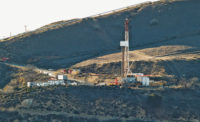California Gov. Jerry Brown (D) declared a state of emergency in Porter Ranch, Calif., on Jan. 7, following the failure of one of the world’s top drilling contractors to plug Southern California Gas Co.’s Aliso Canyon gas leak. Since last fall, the utility’s storage system—depleted oil wells located thousands of feet underground—has emitted more than 1.6 million metric tons of methane in the Los Angeles area.
Brown’s executive order creates emergency regulations and a daily inspection program for the state’s gas distributors, pouring all available state and federal resources into preventing further fallout from deteriorating and problematic transmission infrastructure.
Affected residents and environmentalists are outraged, comparing the Aliso Canyon gas leak to British Petroleum’s 2011 Deepwater Horizon oil spill in terms of the extent of the damage it is causing. Their anger stems, in part, from the length of time required to stop the ongoing disaster and from evidence that SoCal Gas was aware of the failure-causing pipe corrosion in its system but did nothing to mitigate it.
In November 2014, when SoCal Gas applied to increase consumer rates starting on Jan. 1, 2016, the process included proceedings before the California Public Utilities Commission. During testimony, the utility requested revenue increases to address disrepair throughout its transmission system and shortcomings in its own inspection and maintenance programs. To critics, this testimony means SoCal Gas and its parent company, Sempra Utilities, knew the risks posed by Aliso Canyon but did nothing while they tried to get consumers to pay for risk assessments and repairs. In a statement, Brown said the PUC is investigating the gas leak to determine its cause and any possible violations.
The Utility Workers Union of America, which represents the employees of SoCal Gas, has been outspoken for years about safety and maintenance problems on the utility’s system. Eric Hofmann, from UWUA Local 132, said the union testified before the utilities commission in support of SoCal Gas’ request for a rate increase but called for the addition of a working group to coordinate an approach to safety operations and maintenance efforts for pipelines and other storage facilities.
Phillip Baker, SoCal Gas director of underground storage, countered that the request for a working group was “unsupported and unwarranted.”
Critics of the Aliso Canyon “well kill” say the 8,000-ft, directional-drill effort to plug the leak is not unusual and that there is plenty of drilling expertise in the U.S. to do the job within weeks. This leak, however, continues to gush, with officials estimating a complete fix no sooner than March, when the wellhead is cemented and abandoned.
In an emailed statement, the agency supervising SoCal Gas’ recovery effort—the California Dept. of Oil, Gas and Geothermal Resources—detailed the recovery efforts. “Generally, the relief well is being drilled in intervals of about 300 feet. After each interval, the contractors do ‘ranging’ work to ensure they’re still heading toward the leaking well.” At first, the utility mistakenly believed the leak was coming from the wellhead and pumped brine and other materials into the concrete casing. After seven tries, there were concerns the process was putting too much pressure on the well. Then, the department ordered SoCal Gas to pursue an alternative strategy and drill a “relief well” to intersect the leak at a point 8,500 ft below the source. Because of the risk of igniting the escaping gas, the drilling is being done from about 1,500 ft away. “So, the contractor must do several thousands of feet of drilling—both from a distance, at the surface, and underground—and hit the casing of another well, a relatively small target. That requires caution and precision, which takes time,” the department told ENR.
Halliburton subsidiary Boots & Coots is SoCal Gas’ lead contractor on the relief-well drill. SoCal Gas, Sempra Utilities and Halliburton did not respond to ENR’s request for comment.




Post a comment to this article
Report Abusive Comment